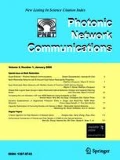Abstract
While in recent years backbone bandwidth has experienced substantial growth, little has changed in the access network. “Last mile” still remains the bottleneck between a high capacity LAN or home network and the backbone. Passive optical network (PON) is a technology viewed by many as an attractive solution to this problem.
In this study, we discuss and evaluate design issues for PON access networks. Specifically, to drive the cost of an access network down, it is very important to have an efficient, scalable solution. We believe that a PON based on polling, with data encapsulated in Ethernet frames, possesses the best qualities, such as dynamic bandwidth distribution, use of a single downstream and a single upstream wavelength, ability to provision a fractional wavelength capacity to each user, and ease of adding a new user.
To support dynamic bandwidth distribution, we propose an interleaved polling algorithm. We then suggest a scheme for in-band signaling that allows using a single wavelength for both downstream data and control message transmission.
To obtain realistic simulation results, we generated synthetic traffic that exhibits the properties of self-similarity and long-range dependence. We then analyzed the network performance and its effect on various types of traffic, e.g., best-effort data traffic, VBR video traffic and CBR streams.
Similar content being viewed by others
References
G. Pesavento, M. Kelsey, PONs for the broadband local loop, Lightwave, PennWell, vol. 16,no. 10, (Sept. 1999), pp. 68–74.
B. Lung, PON architecture “futureproofs” FTTH, Lightwave, PennWell, vol. 16,no. 10, (Sept. 1999), pp. 104–107.
S. Hardy, Verizon staffers find fiber–to–the–home cheaper than copper, Lightwave, PennWell, vol. 17,no. 134, (Dec. 2000), pp. 1.
G. Kramer, B. Mukherjee, G. Pesavento, Ethernet PON (ePON): Design and Analysis of an Optical Access Network, Photonic Network Communications, vol. 3,no. 3, (July 2001), pp. 307–319.
W. Leland, M. Taqqu, W. Willinger, D. Wilson, On the self–similar nature of ethernet traffic (extended version), IEEE/ACM Transactions on Networking, vol. 2,no. 1, (Feb. 1994), pp. 1–15.
S. Clavenna, Metro Optical Ethernet, Lightreading (www.lightreading.com), (Nov. 2000).
K. Claffy, G. Miller, K. Thompson, The nature of the beast: Recent traffic measurements from an internet backbone, in: Proceedings INET '98, (Geneva, Switzerland), (July 1998). Available at http://www.isoc.org/inet98/proceedings/6g/6g_3.htm.
W. Willinger, M. S. Taqqu, A. Erramilli, A bibliographical guide to self–similar traffic and performance modeling for modern high–speed networks, in: Stochastic Networks, eds, F. P. Kelly, S. Zachary, and I. Ziedins, (Oxford University Press, Oxford, 1996), pp. 339–366.
K. Park, W. Willinger, Self–similar network traffic: An overview, in: K. Park and W. Willinger, eds. Self–Similar Network Traffic and Performance Evaluation. (Wiley Interscience, 2000).
A. Adas, Traffic models in broadband networks, IEEE Communications Magazine, vol. 35,no. 7, (July 1997), pp. 82–89.
W. Willinger, M. Taqqu, R. Sherman, D. Wilson, Self–similarity through high–variability: Statistical analysis of Ethernet LAN traffic at the source level, In Proc. ACM SIGCOMM '95, Cambridge, MA, (August 1995), pp. 100–113.
J. L. Hammond, P. J. P. O'Reilly, Performance Analysis of Local Computer Networks, (Addison Wesley, 1987).
M. W. Garrett, W. Willinger, Analysis, modeling and generation of self–similar VBR video traffic, Proc. ACM Sigcomm'94, London, (September 1994), pp. 269–280.
Author information
Authors and Affiliations
Rights and permissions
About this article
Cite this article
Kramer, G., Mukherjee, B. & Pesavento, G. Interleaved Polling with Adaptive Cycle Time (IPACT): A Dynamic Bandwidth Distribution Scheme in an Optical Access Network. Photonic Network Communications 4, 89–107 (2002). https://doi.org/10.1023/A:1012959023043
Issue Date:
DOI: https://doi.org/10.1023/A:1012959023043




